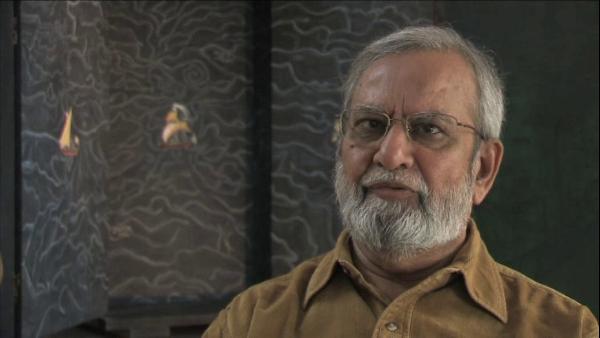NEXT STORY

Religion (Part 2)
RELATED STORIES

NEXT STORY

Religion (Part 2)
RELATED STORIES


|
Views | Duration | |
|---|---|---|---|
| 1. My home town and early life | 131 | 05:28 | |
| 2. School | 77 | 04:11 | |
| 3. Surendranagar town | 71 | 03:49 | |
| 4. My teacher and mentor Labshankar Raval | 73 | 04:46 | |
| 5. The Birdwood Library and Ravishankar Raval | 100 | 06:34 | |
| 6. More about my family | 78 | 06:36 | |
| 7. Religion (Part 1) | 83 | 03:58 | |
| 8. Religion (Part 2) | 65 | 03:30 | |
| 9. Reading, writing and painting | 69 | 03:47 | |
| 10. More about my childhood and my mother | 55 | 06:26 |

The practices in Islam, you know, require that you pray five times a day and... but I do remember that my father subscribed to a magazine which was called Muslim Gujarat which had, among other things, the poetry of Rumi, Masnavi, as they are called. Well, this is Sufi. So, it’s a different kind of literature and he often told me that since you are interested in writing poetry, why don’t you read that? I didn’t find that translation very inspiring or attractive but that was my first brush with some kind of a Sufi tradition.
And did you read the Koran?
We were all made to read Koran. All children have to learn Koran and memorise it sometimes. I could memorise several chapters of it and when I was very young, I could literally recite several chapters. As a young boy they would even ask me to do it in the mosque and I would even do it. I became great friends with one of my classmates who, even until he gave up his studies, but he was son of the priest who was the head priest in the mosque. So, I spent time after the prayers in the mosque and I remember this was a wonderful experience, to be there. You see, the mosque in those days or mosque that I knew didn’t have either a dome or a, even minaret. It was like a house. It’s a green building, small, with a capacity of 100 to 200 people, but there was a little garden and there was a well and there were trees. It was so soothing and so quiet in the afternoon. I would spend my time there with my... and that I became quite close to. He eventually became priest, the boy, and I remember later in my life, you know, when I visited when my brother died, I was attending the ritual and this man was giving the sermon and I thought that he was giving sermon because I was there. He gave a particular sermon, which is a very interesting sermon, I remember it. He talked about prophet and prophet said that, I think the first mosque, when it was built, he, or... there was a question of choosing who will give the first call, first prayer call and he had his great associates, you know, around him but he chose black man called Bilal which is being sort of, you know, considered as a kind of a great act on the part of the prophet, that he was always, you know, he knew all his associates but he also knew people who, whom he considered to be great human beings, I would say. So, I’m just telling it, that he was, while giving the sermon he told this story. When I met him later he said, so he was very pleased. But, anyway, I had to, I did all that during my childhood but then I gave it all up.
Gulammohammed Sheikh is an Indian painter, writer and art critic who has been a major figure in the Indian art world for half a century. His artistic career is closely associated with the renowned MS University of Baroda in Gujarat where after gaining his Master's degree, Sheikh went on to teach in the Faculty of Fine Arts, and where he was appointed Professor of Painting in 1982.
Title: Religion (Part 1)
Listeners: Timothy Hyman
Timothy Hyman is a graduate of Slade School of Fine Art, London, in which he has also taught. In 1980 and 1982, he was Visiting Professor in Baroda, India. Timothy Hyman has curated many significant art exhibitions and has published articles and monographs on both European and Indian artists.
Duration: 3 minutes, 58 seconds
Date story recorded: December 2008
Date story went live: 17 November 2010